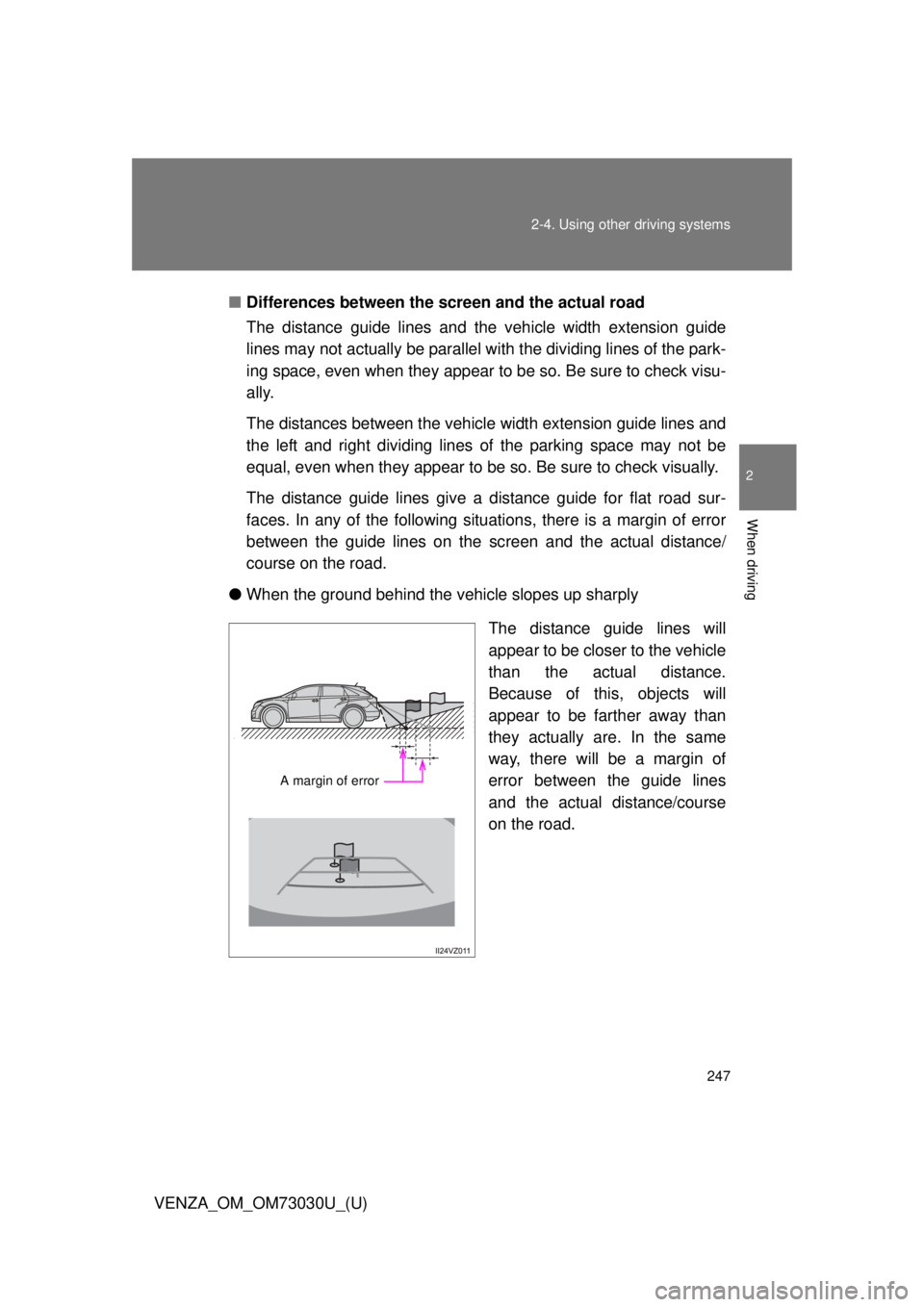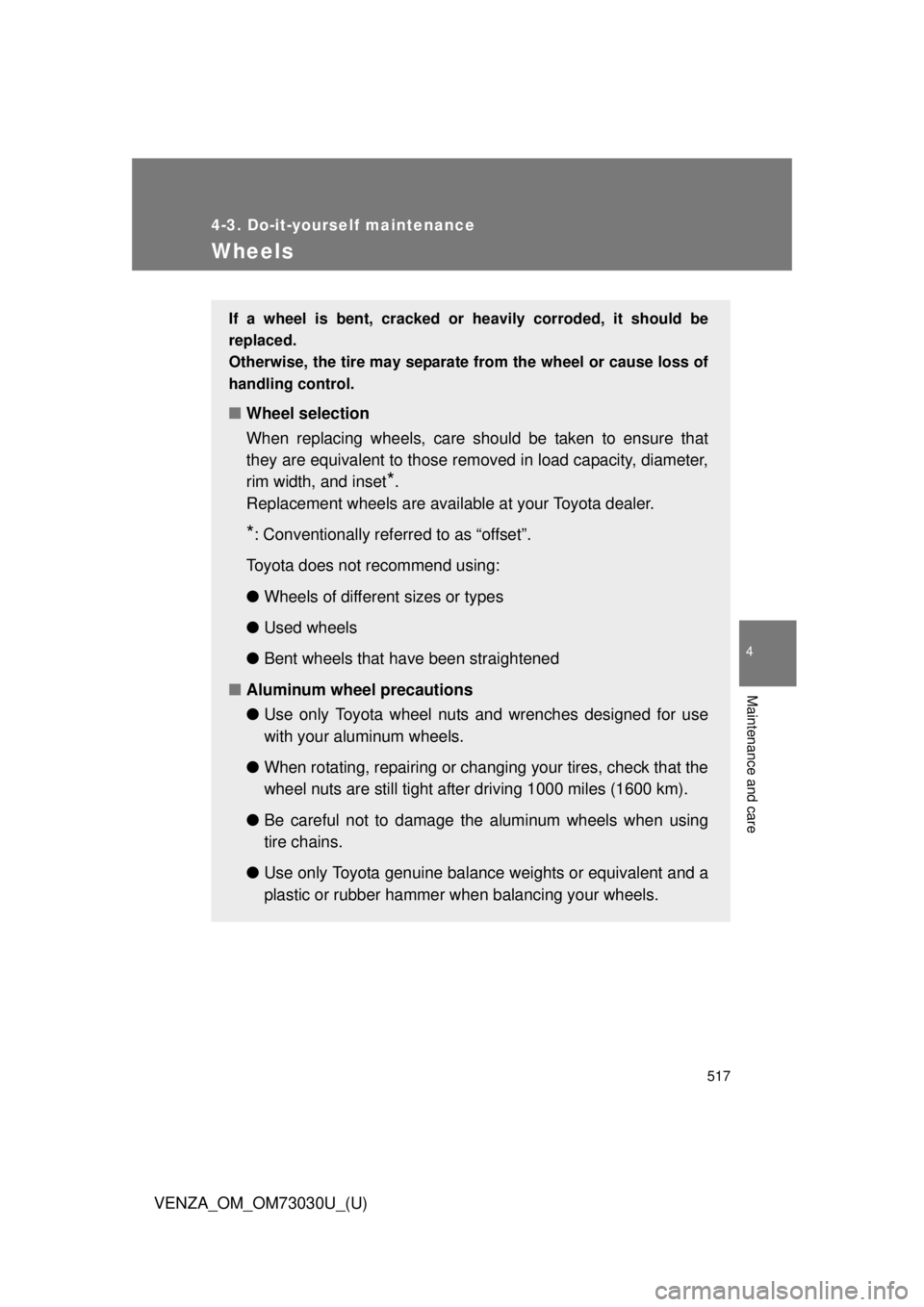Page 244 of 688
2442-4. Using other driving systems
VENZA_OM_OM73030U_(U) Screen description
Guide lines are displayed on the screen.
Guide lines shown differ from those shown on the actual screen.
Vehicle width extension guide lines (blue) The line indicates a guide path when the vehicle is being backed straight
up.
The displayed width is wider than the actual vehicle width.
Distance guide line (blue) This line indicates a position on the ground about 3 ft. (1 m) behind on the
ground of the rear bumper of your vehicle.
Distance guide line (red) This line indicates a position on the ground about 1.5 ft. (0.5 m) behind on
the ground of the rear bumper of your vehicle.
Vehicle center guide lines (blue) These lines indicate the estimated vehicle center on the ground.
Page 247 of 688

2472-4. Using other driving systems
2
When driving
VENZA_OM_OM73030U_(U) ■ Differences between the screen and the actual road
The distance guide lines and the vehicle width extension guide
lines may not actually be parallel wi th the dividing lines of the park-
ing space, even when they appear to be so. Be sure to check visu-
ally.
The distances between the vehicl e width extension guide lines and
the left and right dividing lines of the parking space may not be
equal, even when they appear to be so. Be sure to check visually.
The distance guide lines give a distance guide for flat road sur-
faces. In any of the following situations, there is a margin of error
between the guide lines on the sc reen and the actual distance/
course on the road.
● When the ground behind the vehicle slopes up sharply
The distance guide lines will
appear to be closer to the vehicle
than the actual distance.
Because of this, objects will
appear to be farther away than
they actually are. In the same
way, there will be a margin of
error between the guide lines
and the actual distance/course
on the road.A margin of error
Page 249 of 688
2492-4. Using other driving systems
2
When driving
VENZA_OM_OM73030U_(U) ■ When approaching three-dimensional objects
It is not possible to determine t he position of three-dimensional
objects (such as vehicles) using the vehicle width extension guide
lines and distance guide lines. When approaching a three-dimen-
sional object that extends outward (such as the flatbed of a truck),
be careful of the following.
● Vehicle width extension guide lines
Visually check the surroundings
and the area behind the vehicle.
In the case shown in the illustra-
tion, the truck appears to be out-
side of the vehicle width
extension guide lines and the
vehicle does not look as if it hits
the truck. However, the rear
body of the truck may actually
cross over the vehicle width
extension guide lines. In reality if
you back up as guided by the
vehicle width extension guide
lines, the vehicle may hit the
truck.
Page 517 of 688

5174-3. Do-it-yourself maintenance
4
Maintenance and care
VENZA_OM_OM73030U_(U) Wheels If a wheel is bent, cracked or heavily corroded, it should be
replaced.
Otherwise, the tire may separate from the wheel or cause loss of
handling control.
■ Wheel selection
When replacing wheels, care should be taken to ensure that
they are equivalent to those removed in load capacity, diameter,
rim width, and inset
* .
Replacement wheels are available at your Toyota dealer.
* : Conventionally referred to as “offset”.
Toyota does not recommend using:
● Wheels of different sizes or types
● Used wheels
● Bent wheels that have been straightened
■ Aluminum wheel precautions
● Use only Toyota wheel nuts and wrenches designed for use
with your aluminum wheels.
● When rotating, repairing or changing your tires, check that the
wheel nuts are still tight after driving 1000 miles (1600 km).
● Be careful not to damage the aluminum wheels when using
tire chains.
● Use only Toyota genuine balance weights or equivalent and a
plastic or rubber hammer when balancing your wheels.
Page 612 of 688
612
VENZA_OM_OM73030U_(U) 6-1. Specifications
Maintenance data (fuel, oil level, etc.) Dimensions and weights
* 1
: Unladen vehicle
* 2
: 2WD models
* 3
: AWD models
* 4
: 2GR-FE engine
* 5
: 1AR-FE engineOverall length 189.0 in. (4800 mm)
Overall width 75.0 in. (1905 mm)
Overall height
* 1
63.4 in. (1610 mm)
Wheelbase 109.3 in. (2775 mm)
Tread Front 64.2 in. (1630 mm)
Rear 64.4 in. (1635 mm)
* 2
64.2 in. (1630 mm)
* 3
Vehicle capacity weight
(Occupants + luggage) 895 lb. (405 kg)
Trailer
Weight
Rating
(TWR) Without towing
package 1000 lb. (450 kg)
With towing
package 3500 lb. (1585 kg)
* 4
2500 lb. (1135 kg)
* 5
Page 633 of 688
6336-1. Specifications
6
Vehicle specifications
VENZA_OM_OM73030U_(U) Tire size
■ Typical tire size information
The illustration indicates typical
tire size.
Tire use
(P = Passenger car,
T = Temporary use)
Section width (millimeters)
Aspect ratio
(tire height to section width)
Tire construction code
(R = Radial, D = Diagonal)
Wheel diameter (inches)
Load index (2 digits or 3 digits)
Speed symbol
(alphabet with one letter)
Page 634 of 688
6346-1. Specifications
VENZA_OM_OM73030U_(U) ■ Tire dimensions
Section width
Tire height
Wheel diameter
Tire section names
Bead
Sidewall
Shoulder
Tread
Belt
Inner liner
Reinforcing rubber
Carcass
Rim lines
Bead wires
Chafer ITY61C013
Page 635 of 688

6356-1. Specifications
6
Vehicle specifications
VENZA_OM_OM73030U_(U) Uniform Tire Quality Grading
This information has been prepared in accordance with regulations
issued by the National Highway Tr affic Safety Administration of the
U.S. Department of Transportation.
It provides the purchasers and/or prospective purchasers of Toyota
vehicles with information on uniform tire quality grading. Your Toyota dealer will help answ er any questions you may have as
you read this information.
■ DOT quality grades
All passenger vehicle tires mu st conform to Federal Safety
Requirements in addition to these grades. Quality grades can be
found where applicable on the tire sidewall between tread shoulder
and maximum section width. For example: Treadwear 200 Traction AA Temperature A
■ Treadwear
The treadwear grade is a comparative rating based on the wear
rate of the tire when tested under controlled condit ions on a speci-
fied government test course.
For example, a tire graded 150 would wear one and a half (1 - 1/2)
times as well on the government course as a tire graded 100.
The relative performance of tires depends upon the actual conditions
of their use. Performance may diff er significantly from the norm due
to variations in driving habits, service practices and differences in
road characteristics and climate.